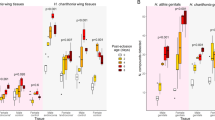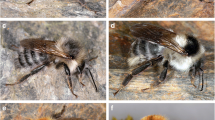Abstract
Pheromones regulating mating behavior are diverse in structure and typically show high species specificity. However, depending on their information content they can also be quite conserved across species. Here, we demonstrate that methyl geranate, an anti-aphrodisiac produced during brood care, is a conserved volatile organic compound within the genus Nicrophorus (burying beetles). Burying beetles are well known for their elaborate biparental care. They reproduce on small vertebrate carcasses and typically it is a pair of beetles, a male and a female, which cooperate in feeding and defending their young. During the intensive period of parental care, female Nicrophorus vespilloides have been shown to emit a volatile substance, methyl geranate, which acts as an anti-aphrodisiac and deters males from copulating. Methyl geranate is biosynthetically linked to juvenile hormone III, a hormone mediating a temporary infertility in this species. By investigating volatile emission of seven geographically and phylogenetically distinct burying beetle species, we provide evidence that methyl geranate is a conserved substance released by parenting adults throughout the genus. We, furthermore, show that there is high quantitative variation (1) between species, which can partly be explained by species differences in body size and (2) within species, which can be attributed to sex differences and individual brood size differences. Moreover, we demonstrate that a species of the genus Ptomascopus, which is closely related to Nicrophorus, but shows no elaborate post-hatching parental behavior, emits only trace amounts of methyl geranate during breeding. Our results, therefore, suggest that the synthesis of an anti-aphrodisiac was an important step in the evolution of concerted parental care in burying beetles. However, behavioral experiments are needed to further corroborate our hypothesis.



Similar content being viewed by others
References
Alonso-Alvarez C, Bertrand S, Devevey G, Gaillard M, Prost J, Faivre B, Sorci G (2004) An experimental test of the dose-dependent effect of carotenoids and immune activation on sexual signals and antioxidant activity. Am Nat 164:651–659
Blomberg SP, Garland T, Ives AR (2003) Testing for phylogenetic signal in comparative data: behavioral traits are more labile. Evolution 57:717–745
Blum MS (1996) Semiochemical parsimony in the Arthropoda. Annu Rev Entomol 41:353–374
Chemnitz J, Jentschke PC, Ayasse M, Steiger S (2015) Beyond species recognition: somatic state affects long-distance sex pheromone communication. Proc R Soc B 282:20150832
Chemnitz J, Bagrii N, Ayasse M, Steiger S (2017) Variation in sex pheromone emission does not reflect immunocompetence but affects attractiveness of male burying beetles—a combination of laboratory and field experiments. Sci Nat 104:53
Dingemanse NJ, Dochtermann NA (2013) Quantifying individual variation in behaviour: mixed-effect modelling approaches. J Anim Ecol 82:39–54
Dötterl S, Wolfe LM, Jürgens A (2005) Qualitative and quantitative analyses of flower scent in Silene latifolia. Phytochemistry 66:203–213
Eggert AK, Müller JK (1989) Pheromone-mediated attraction in burying beetles. Ecol Entomol 14:235–238
Eggert A-K, Müller JK (1997) Biparental care and social evolution in burying beetles: Lessons from the larder. In: Choe JC, Crespi BJ (eds) The evolution of social behavior in insects and arachnids. Cambridge University Press, Cambridge, pp 216–236
Endler JA (1980) Natural selection on color patterns in Poecilia reticulata. Evolution 34:76–91
Engel KC, von Hoermann C, Eggert A-K, Müller JK, Steiger S (2014) When males stop having sex: adaptive insect mating tactics during parental care. Anim Behav 90:245–253
Engel KC, Stökl J, Schweizer R, Vogel H, Ayasse M, Ruther J, Steiger S (2016) A hormone-related female anti-aphrodisiac signals temporary infertility and causes sexual abstinence to synchronize parental care. Nat Commun 7:11035
Faivre B, Grégoire A, Préault M, Cézilly F, Sorci G (2003) Immune activation rapidly mirrored in a secondary sexual trait. Science 300:103–103
Haberer W, Schmitt T, Peschke K, Schreier P, Müller JK (2008) Ethyl 4-methyl heptanoate: a male-produced pheromone of Nicrophorus vespilloides. J Chem Ecol 34:94–98
Haberer W, Schmitt T, Schreier P, Müller JK (2011) Intended and unintended receivers of the male pheromones of the burying beetles Nicrophorus humator and Nicrophorus vespilloides. Entomol Exp Appl 140:122–126
Haberer W, Steiger S, Müller JK (2014) Dynamic changes in volatile emissions of breeding burying beetles. Physiol Entomol 39:153–164
Haberer W, Schmitt T, Schreier P, Eggert A-K, Müller JK (2017) Volatiles emitted by calling males of burying beetles and Ptomascopus morio (Coleoptera: Silphidae: Nicrophorinae) are biogenetically related. J Chem Ecol 43:971–977
Holman L, Lanfear R, d’Ettorre P (2013) The evolution of queen pheromones in the ant genus Lasius. J Evol Biol 26:1549–1558
Holman L, Hanley B, Millar JG (2016) Highly specific responses to queen pheromone in three Lasius ant species. Behav Ecol Sociobiol 70:387–392
Keppner EM, Prang M, Engel KC, Ayasse M, Stökl J, Steiger S (2017) Beyond cuticular hydrocarbons: chemically mediated mate recognition in the subsocial burying beetle Nicrophorus vespilloides. J Chem Ecol 43:84–93
Koch RE, Kavazis AN, Hasselquist D, Hood WR, Zhang Y, Toomey MB, Hill GE (2018) No evidence that carotenoid pigments boost either immune or antioxidant defenses in a songbird. Nat Commun 9:491
Kumar S, Stecher G, Suleski M, Hedges SB (2017) TimeTree: a resource for timelines, timetrees, and divergence times. Mol Biol Evol 34:1812–1819
Ligon RA, Simpson RK, Mason NA, Hill GE, McGraw KJ (2016) Evolutionary innovation and diversification of carotenoid-based pigmentation in finches. Evolution 70:2839–2852
Lozano GA (1994) Carotenoids, parasites, and sexual selection. Oikos 70:309–311
McGraw KJ, Ardia DR (2003) Carotenoids, immunocompetence, and the information content of sexual colors: an experimental test. Am Nat 162:704–712
Müller JK (1987) Replacement of a lost clutch—a strategy for optimal resource utilization in Nicrophorus vespilloides (Coleoptera, Silphidae). Ethology 76:74–80
Müller JK, Eggert A-K (1987) Effects of carrion-independent pheromone emission by male burying beetles (Silphidae: Nicrophorus). Ethology 76:297–304
Nehring V, Steiger S (2018) Sociality and communicative complexity: insights from the other insect societies. Curr Opin Insect Sci 28:19–25
Oi CA, van Zweden JS, Oliveira RC, Van Oystaeyen A, Nascimento FS, Wenseleers T (2015) The origin and evolution of social insect queen pheromones: Novel hypotheses and outstanding problems. BioEssays 37:808–821
Panaitof SC, Scott MP, Borst DW (2004) Plasticity in juvenile hormone in male burying beetles during breeding: physiological consequences of the loss of a mate. J Insect Physiol 50:715–724
Peck SB (1982) The life history of the Japanese carrion beetle, Ptomascopus morio and the origins of parental care in Nicrophorus (Coleoptera, Silphidae, Nicrophini). Psyche 89:107–112
Pukowski E (1933) Ökologische untersuchungen an Necrophorus F. Z Morphol Ökol Tiere 27:518–586
Scott MP (1998) The ecology and behavior of burying beetles. Annu Rev Entomol 43:595–618
Scott MP, Panaitof SC (2004) Social stimuli affect juvenile hormone during breeding in biparental burying beetles (Silphidae: Nicrophorus). Horm Behav 45:159–167
Sikes DS, Venables C (2013) Molecular phylogeny of the burying beetles (Coleoptera: Silphidae: Nicrophorinae). Mol Phylogenet Evol 69:552–565
Smith AA, Liebig J (2017) The evolution of cuticular fertility signals in eusocial insects. Curr Opin Insect Sci 22:79–84
Smith AA, Hölldober B, Liebig J (2009) Cuticular hydrocarbons reliably identify cheaters and allow enforcement of altruism in a social insect. Curr Biol 19:78–81
Steiger S (2015) Recognition and family life: recognition mechanisms in the biparental burying beetle. In: Aquiloni L, Tricarico E (eds) Social recognition in invertebrates. Springer, Basel, pp 249–266
Steiger S, Stökl J (2017) Pheromones involved in insect parental care and family life. Curr Opin Insect Sci 24:89–95
Steiger S, Stökl J (2018) Pheromones regulating reproduction in subsocial beetles: Insights with references to eusocial insects. J Chem Ecol 44:785–795
Steiger S, Peschke K, Francke W, Müller JK (2007) The smell of parents: breeding status influences cuticular hydrocarbon pattern in the burying beetle Nicrophorus vespilloides. Proc R Soc B 274:2211–2220
Steiger S, Whitlow S, Peschke K, Müller JK (2009) Surface chemicals inform about sex and breeding status in the biparental Burying beetle Nicrophorus vespilloides. Ethology 115:178–185
Steiger S, Haberer W, Müller JK (2011) Social environment determines degree of chemical signalling. Biol Lett 7:822–824
Stökl J, Steiger S (2017) Evolutionary origin of insect pheromones. Curr Opin Insect Sci 24:36–42
Suzuki S, Nagano M, Kobayashi N (2006) Mating competition and parentage assessment in Ptomascopus morio (Coleoptera: Silphidae): a case for resource defense polygyny. Eur J Entomol 103:751–755
Symonds MRE, Elgar MA (2008) The evolution of pheromone diversity. Trends Ecol Evol 23:220–228
Symonds MRE, Wertheim B (2005) The mode of evolution of aggregation pheromones in Drosophila species. J Evol Biol 18:1253–1263
Tibbetts EA, Dale J (2007) Individual recognition: it is good to be different. Trends Ecol Evol 22:529–537
Trumbo ST, Robinson GE (2008) Social and nonsocial stimuli and juvenile hormone titer in a male burying beetle, Nicrophorus orbicollis. J Insect Physiol 54:630–635
Trumbo ST, Kon M, Sikes D (2001) The reproductive biology of Ptomascopus morio, a brood parasite of Nicrophorus. J Zool 255:543–560
Van Oystaeyen A, Oliveira RC, Holman L, van Zweden JS, Romero C, Oi CA, d’Ettorre P, Khalesi M, Billen J, Wäckers F, Millar JG, Wenseleers T (2014) Conserved class of queen pheromones stops social insect workers from reproducing. Science 343:287–290
Van de Pol M, Wright J (2009) A simple method for distinguishing within- versus between-subject effects using mixed models. Anim Behav 77:753–758
Whitlow S (2003) Chemical and behavioural investigations into species and partner recognition in burying beetles, Ph.D. thesis. University of Freiburg, Freiburg
Wyatt TD (2014) Pheromones and animal behavior: chemical signals and signatures. Cambridge University Press, Cambridge
Acknowledgements
We are very grateful to Josef K. Müller for providing access to some Nicrophorus species and for valuable discussion. We thank Madlen Prang and Rainer Blum for helping to rear and maintain the beetles and Wolf Haberer, Johannes Stökl and Alexandra Capodeanu-Nägler for discussion and statistical advice. Furthermore, we thank Allen Moore and two anonymous reviewers for helpful and constructive comments on the manuscript. The research was supported by grants of the German Research Foundation (DFG) to S.S. (STE 1874/3-1 and STE 187/7-1).
Author information
Authors and Affiliations
Corresponding author
Additional information
Communicated by Thomas Schmitt.
Electronic supplementary material
Below is the link to the electronic supplementary material.
Rights and permissions
About this article
Cite this article
Engel, K.C., Hwang, W. & Steiger, S. A pheromone that coordinates parental care is evolutionary conserved among burying beetles (Silphidae: Nicrophorus). Chemoecology 29, 1–9 (2019). https://doi.org/10.1007/s00049-018-0271-7
Received:
Accepted:
Published:
Issue Date:
DOI: https://doi.org/10.1007/s00049-018-0271-7




